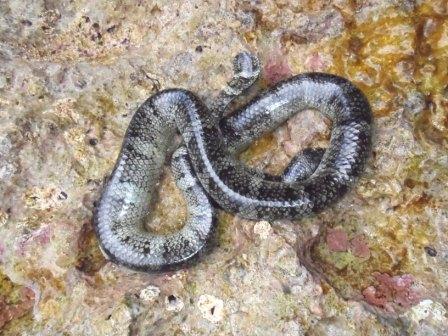Sea krait

VulcanSpirit
Richard & Alison Brunstrom
Fri 31 Aug 2012 18:25
|
Niue is famous for its sea kraits, a type of sea
snake.
There are about 60 species of sea snake, but only
about eight of them are kraits. Sea snakes are all related to the boas; they are
true snakes that evolved on land and have secondarily returned to the sea. Krait
are the most primitive - they are distinguished by retaining their belly scales
which enables them to move on land, and by laying eggs on land (all other sea
snakes have lost the ability to move on land, and are viviparous). All sea
snakes are venemous, and their poison is very strong indeed, but they rarely
bite humans. The kraits in particular have small mouths and are generally
extremely placid, putting up with being handled without complaint. Here in Niue
the local endemic krait Laticauda shistorynchus is extremely
common and is seen in surprising numbers on every dive or swim.
Here is one sunning itself on a rock:
 A big krait can reach over 3m, but this one is
1.5m. You can see its flattened paddle-like tail at the top while its head is
tucked under to the bottom right. These are very beautiful animals. They feed
largely on eels which they hunt in the reef (the reef here is limestone of
course, but honeycombed with holes ideal for eels). Kraits have a single lung
and can stay down for an hour of so - but they can also breathe through their
skin, receiving about 25% of their oxygen by this method (which I presume is
going to continue to evolve over the next few million years as they become more
marine). Kraits lay eggs on land, often in sea caves - I was able to enter one
underwater from the sea, and found baby snakes on the cave walls.
Fantastic.
Here is a krait swimming, heading up to the surface
to breathe:
 This guy is also about 1.5m; the picture also gives
you a good idea of the clarity of the water - an astonishing 40-50m visibility,
some of the clearest in the world because there is almost no surface
runoff. The snakes do not seem to take any notice of being caught and held
underwater; they just stay still until they are
released.
|